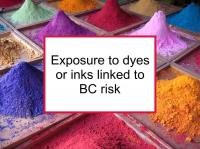Although most occupations have not been linked to breast cancer risk, significant links have been found for some. These occupations fall broadly into those involving night shift work (e.g., nurses), radiation exposure (orthopedic surgeons), or exposure to harmful chemicals. The use of electric blankets has been linked to breast cancer risk.
However, living or working near power lines does not appear to be a risk factor. Now a new prospective study presented at the 2014 American Association for Cancer Research (AACR) Annual Meeting has reported that significant occupational exposure to dyes or inks is associated with increased risk of breast cancer.
Manufacturing and other jobs linked to breast cancer
Potentially harmful exposures to carcinogens (some known and others not yet classified as such) and endocrine disruptors (chemicals that interfere with hormone systems in the body) are common in a variety of occupational settings. In many cases, living near manufacturing and other plants also increases risk. Women with occupations (including plant administrative support) in the following industries have been found to have elevated risks of breast cancer:Men who have worked in blast furnaces, steel works, or rolling mills have also been found to have a higher likelihood of breast cancer, as have male workers in machinery repair and manufacturing of motor vehicles. Some military bases have unusually high rates of male breast cancer.
- Dry cleaners using tetrachloroethylene
- Metal working operations, including jewelry making
- Farms (during pesticide application)
- Gas stations
- Auto repair shops
- Food canning
- Recycling or waste disposal facilities
- Textile plants
- Petroleum refineries
- Rubber and plastics manufacturing plants
- Thermal power plants
- Electrical manufacturing plants
- Pulp mills
- Steel mills
- Metal smelting plants
- Military bases incorporating any of the above operations
Latest research finds exposure to dyes or inks increases risk
The prospective study referenced at the beginning of this news article was designed to investigate the links between work-based exposures to endocrine disruptors and risk of breast cancer. The study included 47,755 women enrolled in the Sister Study, which is investigating potential genetic and environmental breast cancer risk factors among U.S. and Puerto Rican women. The women entered the Sister Study at ages ranging from 33 to 74 during the period 2004 to 2009 and have been followed ever since. Study participants completed a comprehensive questionnaire upon enrollment that included questions about occupational exposures to the following nine types of endocrine disrupting compounds: dyes or inks; paints; stains; glues or adhesives; gasoline or other petroleum products; lubricating oils; organic solvents; metals; and pesticides. The authors used this data to estimate cumulative lifetime exposure to each type of endocrine disruptor and divide the women into four groups (quartiles) according to their levels of exposure. Results were adjusted for known breast cancer risk factors.
A total of 1,789 of the study participants were diagnosed with breast cancer during the study period. Women in the highest quartile of occupational exposure to dyes or inks were found to have 1.7 times the risk of estrogen receptor positive (ER+) breast cancer as women without such exposure. Dyes and inks typically incorporate endocrine disruptors such as organic compounds and heavy metals. Elevated risks were also seen for women in the highest quartiles of occupational exposure to gasoline or other petroleum products (1.7 times) and metals (1.5 times), but these results did not reach statistical significance. The authors conclude that exposure to occupational dyes or inks might increase breast cancer risk. Further studies are needed to clarify the role of these compounds in breast cancer.
Please see our article on occupations associated with increased breast cancer risk for more information.
